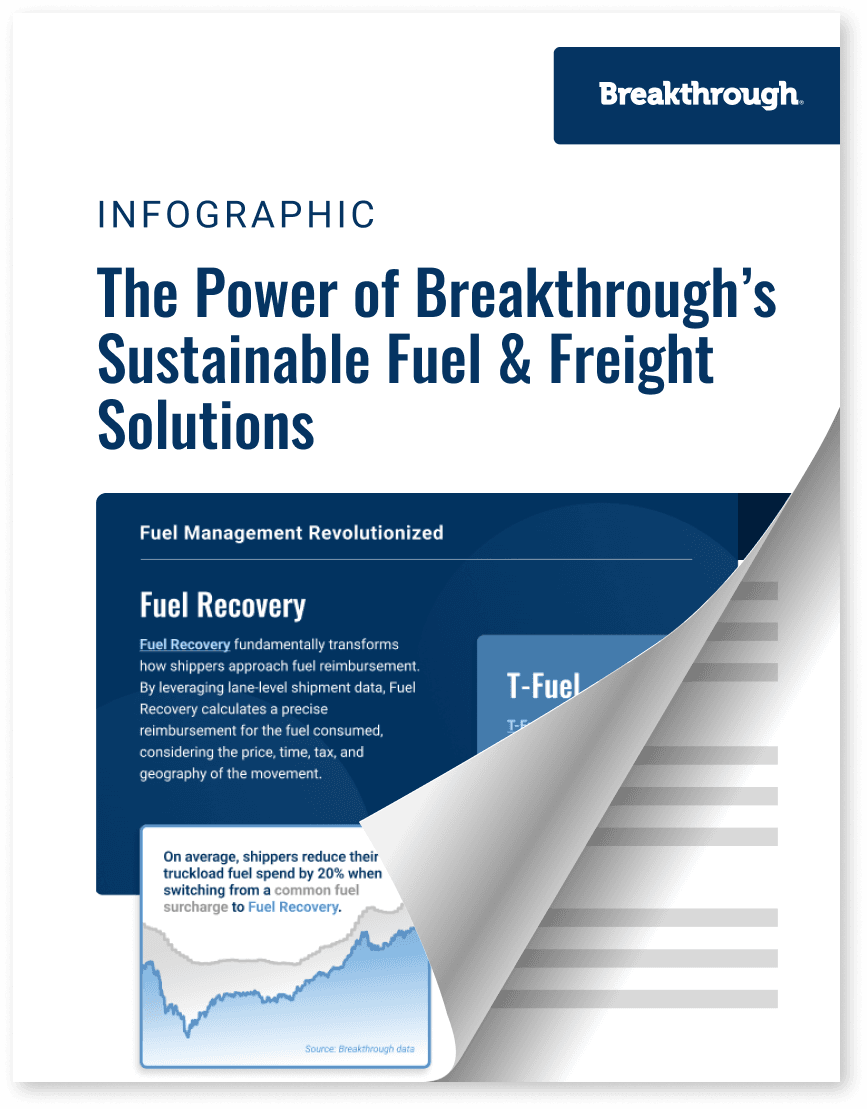The Power of Breakthrough's Sustainable Fuel and Freight Solutions

Freight
3 min read
July 17, 2024
Market Events
4 min read
July 16, 2024
Market Events
3 min read
July 8, 2024

5 min read
September 26, 2023

Share:
In January 2023, the Energy Information Administration projected diesel prices would decline throughout the year and into 2024. That projection was based on increased global refinery production coinciding with a slight dip in demand thanks to improved fuel efficiency in new vehicles.
Nine months later, shippers still holding out hope for cost relief are likely to be disappointed. All evidence points to diesel fuel prices climbing intoQ4 and remaining high next year.
So, how will shippers respond?
The pain of elevated diesel fuel costs will encourage many to adopt alternative energies faster, especially if costs remain high for an extended period — but that’s not the full story. To be successful in the years and decades ahead, it will be critical for shippers to adopt a polyfuel strategy that encompasses a range of alternative energies like electric, hydrogen, natural gas, renewable diesel and biodiesel alongside traditional diesel fuel.
And now is the time to start planning your polyfuel future.
A variety of macroeconomic forces have constrained global crude oil production, causing U.S. exports to remain high. Diesel prices climbed over the summer months and will likely peak during the fourth quarter in line with typical seasonal diesel price changes — and stay inflated into the new year.
In the meantime, elevated diesel prices are encouraging more focus on the adoption of commercially viable and scalable fuel efficiency technologies and alternative energies. If diesel prices were projected to remain at more affordable levels, the same ambitions may not exist. These conditions present an opportunity for shippers to balance emissions reduction targets with fuel costs.
Emerging fuel efficiency technologies for class 8 trucks can also help limit commercial transportations emissions while reducing fuel costs. For example, the highest performing trucks achieve a fuel efficiency rate of more than nine miles per gallon, compared with a market average of seven miles per gallon — an improvement of more than 25%.
A focus on deploying these advanced technologies will dramatically reduce transportation carbon emissions in the near term. But even with fuel efficiency improvements, it still won’t be possible to meet ambitious emissions reduction targets and regulatory requirements without incorporating alternative energy into your transportation network.
Legislation that incentivizes minimizing carbon emissions is having a significant impact on the pace of alternative energy development and adoption. A good example is California’s Low Carbon Fuel Standard, a cap-and-trade program that incentivizes the production and use of low-carbon fuels, which went into effect in 2011. Today, more than 50% of all diesel fuel consumed in the state is a blend of renewable diesel and biodiesel.
And legislation in one state can have spillover effects in others. Nearby Oregon and Washington, as well as the Canadian province of British Columbia, have adopted similar legislation. With California, they have also entered into a pact called the Pacific Coast Collaborative to strategically align their policies to reduce greenhouse gas emissions along the West Coast.
These regulatory incentives are having a real impact on the economics of the transportation market, especially because the price of diesel has remained elevated for an extended period. No other area of the country has experienced such rapid growth of renewable diesel and biodiesel in such a short timeframe.
It’s likely other pockets of similar regulations will emerge across the U.S., particularly in the Northeast. However, it takes time for policies to be implemented and for the market to respond. Though significant gains in alternative energies are expected, conventional diesel fuel will retain the majority of market share, at least until 2035. But that doesn’t mean you can or should delay plans for a polyfuel future.
Major changes to the energy market will unfold gradually over the next decade. You can simultaneously reduce cost and boost emissions efficiency with a data-driven polyfuel strategy. This proactive approach enables you to gain first hand experience with new energy efficiency technologies and fuel alternatives so you’re able to move with agility as diesel’s market dominance declines.
To successfully navigate the changing energy market, it’s critical that your team has access to:
There’s no doubt diesel fuel will remain a major part of your transportation strategy for the foreseeable future — but it can’t be the only solution. Viable alternative energy technology is gaining ground and sustainability concerns are growing. By adopting a polyfuel strategy early, you can become a market leader in reducing transportation emissions and take advantage of policy incentives for doing so.
Breakthrough’s CleanMile solution gives you access to the lane-level data and market insights you need to start planning your polyfuel future. Get in touch to learn more about our solutions and schedule a demo.

3 min read
July 17, 2024
Maximize transportation efficiency with cohesive fuel and freight strategies. Discover the power of enhanced visibility, cost-effectiveness, and sustainability.
Read more
4 min read
July 16, 2024
Discover how the recent elections in Mexico and the EU are expected to influence energy policies, fuel prices, and dynamics in the transportation sector.
Read more
3 min read
July 8, 2024
Understand the state-specific changes in diesel tax rates and explore strategic solutions for shippers to accurately calculate fuel reimbursements to carriers.
Read more